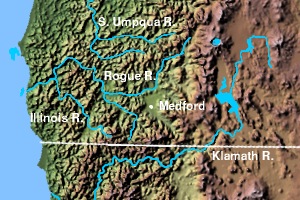Rogue Valley AVA facts for kids
| Wine region | |

Rogue River and its smaller rivers.
|
|
| Type | American Viticultural Area |
|---|---|
| Year established | 2000 |
| Country | United States |
| Part of | Oregon, Southern Oregon AVA |
| Sub-regions | Applegate Valley AVA |
| Climate region | Maritime |
| Total area | 1,150,000 acres (1,797 sq mi) |
| Size of planted vineyards | 1,100 acres (450 ha) |
| Grapes produced | Cabernet Franc, Cabernet Sauvignon, Chardonnay, Dolcetto, Gewurztraminer, Grenache, Malbec, Merlot, Pinot blanc, Pinot gris, Pinot noir, Sangiovese, Sauvignon blanc, Semillon, Syrah, Tempranillo, Viognier |
| No. of wineries | 20 |
The Rogue Valley AVA is a special area in southern Oregon where grapes are grown. "AVA" stands for American Viticultural Area. It means the United States government has officially recognized this region as unique for growing grapes. This area was approved in 1991.
The Rogue Valley AVA is part of a larger area called the Southern Oregon AVA. It includes the Rogue River and other rivers like the Illinois River, the Applegate River, and Bear Creek. Most grape farms here are found along these smaller rivers, not the main Rogue River.
The region is about 70 miles (113 km) wide and 60 miles (97 km) long. Not all of this land is used for growing grapes. There are fewer than 20 grape farms, with only about 1,100 acres (450 ha) of land planted. Each river valley in the Rogue Valley AVA has its own special "terroir". This French word describes how the soil, climate, and landscape affect the grapes. Because of this, different types of grapes grow well in different valleys. Overall, this region is the warmest and driest place in Oregon for growing grapes.
Contents
Exploring the Rogue Valley's Grape-Growing Areas
Applegate Valley: A Special Place for Grapes
The Applegate Valley AVA is a smaller, special grape-growing area within the Rogue Valley. It was created in 2000. The Applegate River flows through this valley. Near the city of Jacksonville, you can find the site of Oregon's very first grape farm! It has been fixed up and is now called Valley View Winery.
Grape farms in the Applegate Valley are located at heights from 1,000 feet (300 m) to 1,500 feet (500 m) above sea level. This valley is warmer and drier than the Illinois Valley to its west. But it's not as warm and dry as the Bear Creek Valley to its east. Grapes like Merlot, Cabernet Sauvignon, Syrah, Chardonnay, and Zinfandel grow well here. Merlot and Cabernet Sauvignon are the most common types.
Bear Creek Valley: Warm and Dry
Bear Creek flows through cities like Medford and Ashland. This makes it the most populated valley of the Rogue River's smaller rivers. The valley floor here is about 2,000 feet (610 m) above sea level. The weather is warm and dry, much like the famous grape-growing region of Bordeaux in France. This climate is great for grapes such as Cabernet Sauvignon, Merlot, Chardonnay, Cabernet Franc, Pinot gris, Sauvignon blanc, Malbec, and Syrah.
Illinois Valley: Cool and Coastal
The Illinois River is the westernmost river that flows into the Rogue River. It starts in southern Josephine County. The river flows northwest through places like Cave Junction and the Siskiyou National Forest. It joins the Rogue River about 15 miles (24 km) from the Pacific Ocean.
This area is high up in the mountains. It gets a lot of influence from the ocean's weather. This makes it cooler than the other valleys. Because of this, the Illinois Valley is good for growing grape types similar to those found in the Willamette Valley AVA in northern Oregon. These are often called "Burgundy varietals."

